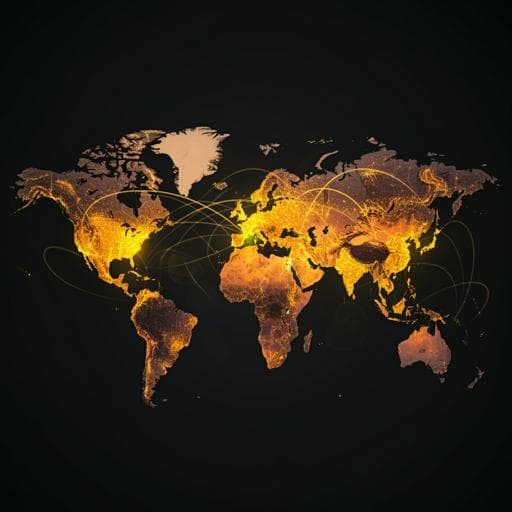
Medicine and Health
Population at risk of dengue virus transmission has increased due to coupled climate factors and population growth
T. Nakase, M. Giovanetti, et al.
A recent study reveals alarming trends in dengue virus transmission, driven by climate changes and urban growth. From 1979 to 2022, regions in North America, East Asia, and the Mediterranean basin have seen a surge in climate suitability for dengue, affecting over 2.5 billion people globally. This pivotal research, conducted by Taishi Nakase, Marta Giovanetti, Uri Obolski, and José Lourenço, sheds light on the future of dengue dynamics.
~3 min • Beginner • English
Introduction
Dengue is the most common mosquito-borne viral disease, causing an estimated 60 million symptomatic cases annually across 130 countries. Aedes aegypti, the primary urban vector, thrives in tropical and subtropical regions where climate (temperature and humidity) and anthropogenic factors (urbanization, population growth) shape transmission potential. Climate modulates mosquito lifespan, development, viral incubation, and biting, with higher temperatures and humidity generally increasing transmission potential until extremes reduce survival. The disease burden has expanded geographically to more temperate regions, with increasing autochthonous transmission in parts of North America and southern Europe. While mechanistic and statistical models have mapped current and projected future risk, the extent to which historical environmental changes have shaped present-day limits and activity has been less explored. This study asks how observed changes in temperature and humidity (summarized by a mechanistic climate suitability index) and population growth from 1979 to 2022 altered the global geography and the number of people living in areas with high climate suitability for dengue virus transmission, and how these changes differ across regions, income groups, population densities, and climate zones.
Literature Review
Previous work has developed mechanistic suitability indices for dengue that link climate to mosquito and viral traits without relying on potentially biased or sparse epidemiological data. These indices capture non-linear, seasonal dynamics and have shown good correspondence with observed dengue timing and distribution. Many approaches, however, are temperature-only or lack broad validation. Statistical species distribution models can be hampered by reporting biases, sparse data where transmission is low, and difficulty modeling non-linear interactions, often relying on single thresholds that miss seasonal dynamics. Prior efforts often use locally specific parameters limiting generalizability, and the literature has emphasized future projections more than historical changes. There is also recognition of the potential role of Aedes albopictus, especially in temperate zones, though empirical trait data to parameterize humidity- and temperature-dependent mechanistic models for this species remain limited.
Methodology
Climate-based transmission suitability was quantified using Index P, a mechanistic suitability measure for Aedes aegypti that integrates temperature and relative humidity effects on mosquito-viral traits (extrinsic incubation period, lifespan, biting rate, transmission probabilities), with climate-independent parameters (human incubation and infectious periods, lifespan) held constant. Monthly Index P was obtained for a global 360-arcsecond grid (~11 km) from 1979–2022 using Copernicus surface air temperature and relative humidity. Past and present suitability were summarized as the mean Index P for 1979–1983 and 2018–2022, with uncertainty via 1000 samples to derive 50% and 90% credible intervals. A threshold of 0.5 defined high suitability, motivated by prior observed incidence plateaus and theoretical linkage to R0 ≈ 1 assuming two adult female mosquitoes per host.
Validation: Index P was aggregated to administrative units and compared to dengue incidence in Brazil, Colombia, Costa Rica, Taiwan, Thailand, and Vietnam using Tobit censored regression (log mean annual incidence outcome; high vs low suitability; covariates: log population density and log population size). Country-specific estimates were meta-analyzed using a random-effects model with REML.
Trend analysis: Long-term trends in monthly Index P per pixel (1979–2022) were assessed using the seasonal Mann–Kendall test with Yue–Pilon prewhitening to address autocorrelation and Sen’s slope for rate estimation. Significance was defined at FDR q < 0.10.
Land and population at high risk: Global gridded population counts and densities for 1980 and 2020 (30-arcsecond SEDAC and WorldPop) were aggregated to 360-arcsecond resolution. Population in high-risk areas was computed by overlaying Index P ≥ 0.5 pixels with population for past (1979–1983 ~ 1980) and present (2018–2022 ~ 2020). Independent contributions were estimated via counterfactual scenarios: (i) hold 1980 population constant, allow climate to change (climate effect); (ii) hold 1979–1983 climate constant, allow population to change (population effect). Combined effects were also computed. Analyses were stratified by population density categories (≤100, 101–300, 301–1500, ≥1501 people/km²), World Bank 2024 income groups, and Köppen–Geiger climate zones (tropical, dry, temperate, continental, polar), with climate zone data resampled to 360-arcsecond resolution via nearest neighbor. All analyses were conducted in R 4.2.1.
Key Findings
- Index P successfully discriminated higher dengue incidence in high-suitability areas across multiple countries; meta-analysis showed an 11-fold (95% CI 4–36) higher incidence in high vs low suitability regions. Country examples: Brazil 37-fold (95% CI 33–42); Colombia 3-fold (95% CI 2–5).
- Long-term trends: 28.5% of global land area (≈38.2 million km²) exhibited significant monotonic changes in suitability (FDR q < 0.10), concentrated in equatorial tropical/subtropical zones. Regional shares with trends: South America 37.4% (6.6 million km²), Africa 51.4% (15.3 million km²), Asia 26.5% (11.8 million km²).
- Geographic shifts in high-suitability land (Index P ≥ 0.5) from 1979–1983 to 2018–2022: global proportion increased from 38.4% to 39.5% (Δ 1.1 pp; 90% CI 0.9–1.4), roughly +1.5 million km². Asia increased by 0.8 million km² (24.4% to 26.2%; Δ 1.8 pp, 90% CI 1.4–2.2); North America increased by 0.6 million km² (12.2% to 14.8%; Δ 2.6 pp, 90% CI 1.5–3.1). Africa showed offsetting regional expansions and contractions with little net change. Local changes included marked increases (e.g., Angola +17.1 pp, +220,000 km²; Namibia +16.0 pp, +130,000 km²; DRC +4.6 pp, +110,000 km²) and decreases (e.g., Algeria −14.8 pp, −350,000 km²; Sudan −9.0 pp, −170,000 km²; Mauritania −15.0 pp, −160,000 km²).
- Population in high-suitability areas rose from 48.8% to 60.0% globally (Δ 10.8 pp; 90% CI 10.0–11.8), equating to roughly 2.5 billion additional people. In absolute terms: Asia +1.68 billion (major contributors: India, China, Pakistan, Indonesia, Bangladesh), Africa +569 million (notably West Africa, including Nigeria), North America +113 million, South America +94 million.
- Decomposition: Globally, population growth alone accounted for +2.16 billion and climate change alone for +182 million additional people in high-suitability areas; their sum (2.34 billion) was slightly less than the combined observed effect (2.46 billion), indicating growth in locations newly crossing the suitability threshold. In the Global North, climate effects (≈59 million) exceeded population growth effects (≈45 million); elsewhere, population effects dominated.
- Stratifications: High-density areas (301–1500 people/km²) with high suitability increased from 58.5% to 66.2% (Δ 7.7 pp; 90% CI 4.7–13.0); very high density (≥1501 people/km²) from 48.1% to 63.6% (Δ 15.5 pp; 90% CI 14.1–17.0). Upper-middle income economies increased from 31.6% to 32.9% (Δ 1.3 pp; 90% CI 0.2–2.4) and high-income from 20.5% to 22.2% (Δ 1.6 pp; 90% CI 0.3–2.5). Temperate climate zones had the largest net change (25.2% to 30.5%; Δ 5.3 pp; 90% CI 3.2–6.2), while tropical zones increased from 87.5% to 90.1% (Δ 2.6 pp; 90% CI 1.3–3.5).
- Regional patterns: Increases in suitability were observed in southern United States, northeastern Brazil, western/southern Africa, Indian subcontinent, Southeast Asia, and coastal Europe; decreases occurred in northern Australia, parts of South America, and northeast Africa.
Discussion
Findings indicate that climate suitability increases over the past four decades were concentrated within traditionally high-suitability regions (Sub-Saharan Africa, Southeast Asia, northern South America), with notable expansion to temperate environments in North America, East Asia, and the Mediterranean. Despite modest global expansion of high-suitability land, large demographic changes placed substantially more people in suitable areas. Importantly, drivers differ by region: the Global South saw large population growth in historically suitable areas with limited net expansion of suitable land, whereas the Global North experienced significant expansion of suitable land with comparatively modest population growth. Some regions, particularly Northern and Eastern Africa, showed decreasing suitability, suggesting warming and drying may be reducing mosquito-viral fitness, although many such areas remain favorable and may continue to sustain transmission for years. The strengthening of suitability in populous, high-density urban areas supports the hypothesis that urbanization patterns amplify recent dengue risk, aligning with studies linking high density and poor urban infrastructure to transmission. Results refine near-term public health prioritization: increased activity is most likely in the Global South (Asia and West Africa), while the Global North faces growing receptivity to introductions due to expanding suitability in temperate zones.
Conclusion
This study quantifies how historical changes in temperature and humidity, together with population growth, have reshaped the geography and size of populations living in areas climatically suitable for dengue transmission since 1979. It shows a modest global expansion of high-suitability land but a large increase—about 2.5 billion—in people living in such areas, with population growth dominating in the Global South and climate-driven expansion dominating in the Global North. The work informs immediate resource allocation, including vector control and deployment of tools such as the TAK-003 vaccine, prioritizing high-burden regions in the Global South while recognizing growing suitability in temperate regions. Future research should integrate additional environmental drivers (precipitation, altitude, vegetation, urbanization), incorporate Aedes albopictus where data permit, and model interactions among long-term climate trends, recurrent/extreme events (e.g., ENSO, heat waves, floods), and teleconnections to refine risk assessments and intervention strategies.
Limitations
The suitability index relies only on temperature and relative humidity and does not include other influential factors like precipitation, altitude, urbanization, vegetation, or availability of breeding habitats, which may cause discrepancies (e.g., arid regions or sparsely populated areas with limited transmission despite high suitability). The index assumes presence of vectors, hosts, and virus; high suitability does not guarantee transmission. Validation is limited to available surveillance data that may suffer under-reporting or bias, particularly in parts of Africa and the Amazon. Aedes albopictus contributions are not modeled due to insufficient empirical trait data for full parameterization including humidity effects, potentially underestimating suitability in temperate regions where this species is established. Income group classifications and climate zones were treated as static over time. Summaries of past vs present use five-year windows and gridded datasets at fixed spatial resolutions, which may smooth local heterogeneities.
Related Publications
Explore these studies to deepen your understanding of the subject.







